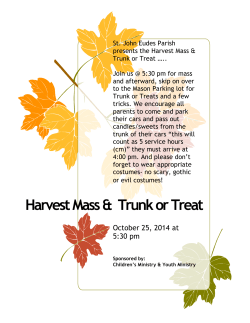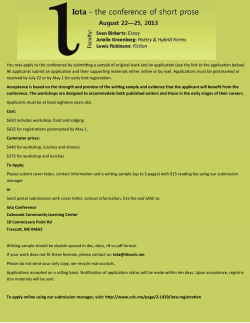
Strategies and Progress, PSHB Control
Strategies and Progress, PSHB Control PSHB Grower Outreach Mee:ng 24 March 2015, Escondido, CA (revised 3-‐25-‐15) Joseph Morse1, Frank Byrne1, Akif Eskalen1, Richard Stouthamer1, Bryan Vander Mey2, and Jim Bethke2 1 University of California, Riverside, CA 2 University of California Coopera:ve Extension, San Marcos, San Diego County, CA Sanita:on – Disposing of Infested Branches • Meant only as a means of removing limbs that are going to die / reducing PSHB levels – Chipping limbs / branches – Fumiga:on with phosphine gas – Burning (burn permit) – Other methods (solariza:on during the summer?) • Must realize it will be impossible to remove all beetles from infected limbs / will face re-‐invasion • See Morse presenta:on – CAC Greensheet online archives Vol. 31, Issue 1, January 6, 2015 Research Strategies – Pes:cide Studies § Borrowing heavily from work done in Florida on laurel wilt and its vectors, elm bark beetle research, work in Israel, etc. § Neonico:noids (imidacloprid, others) unlikely to be highly effec:ve – don’t have strong inherent ac:vity against beetles (Bayer CropScience, researchers) § Most of the pes:cides registered for use on avocados are unlikely to be persistently effec:ve § IR-‐4 process to register new materials is slow – typically 4-‐5 years (perhaps Sec:on 18 in Yr 2-‐3) Research Strategies – Pes:cide Studies (other ideas?) § Screening various systemic fungicides and endophy:c bacteria and fungi -‐ Akif Eskalen § Systemic insec:cides/ monitor movement -‐ Frank Byrne § Evaluate different methods of injec:on/ infusion (Crane, infusion, Arborjet, Mauget, others) – Eskalen, Byrne § Urban tree systemic evalua:ons (avoid crop destruct, extra non-‐CAC funding) – Eskalen, Tim Paine, John Kabashima § Beauveria trunk sprays – Peoria, IL USDA lab (formula:ons), Akif Eskalen, Richard Stouthamer (Isaria, Metarhizium also) § Trunk sprays of tradi:onal / experimental pes:cides – Bryan Vander Mey § Adract and kill traps, beder lures – Stouthamer, Morse The Reality of Chemical Control of PSHB / Fusarium § Tree infusion / injec:on is going to be laborious and expensive (cost of product, labor to inject) § May be the best we have in the near future and if control lasts 2-‐3 years, that would be beder § Experimental work needed to iden:fy the most effec:ve / fastest methods of infusion/injec:on § Trunk sprays are unlikely to be very persistent – laborious, expensive, may require new spray equipment (lower volume, higher concentra:on), and would require frequent re-‐applica:on § If we could make adract and kill bait sta:ons work (new, more effec:ve lures?), they might be a very adrac:ve op:on (compe::on to drive down lure price) 1. Tilt Sec:on 18 Request for Fusarium control § § Ken Melban has started the Sec:on 18 applica:on process, IR-‐4 will provide documenta:on, ini:al Syngenta contacts made Model afer the current Florida Sec:on 18 for laurel wilt control § Tilt fungicide (propiconazole), 3.6 lbs ai/gal; 12 h REI, 0 d PHI; Warning label § Use as a macro-‐infusion into flare roots or as an injec:on at the base of the tree and along major limbs; in younger trees, as a spray directed to the bark by hand-‐gun (research) § Limit of 252 fl oz/ acre/ year (1.97 gal); cost is approximately $90/gal + tax – use 0.25 fl oz (7.4 ml) per inch of trunk diameter – see diagram from Jonathan Crane (UFL) § If average diameter > 10”, may have to treat 50% of grove in alternate years (IR-‐4 two applica:ons 90 d apart, no acre limit) § 1-‐3 applica:ons per year; FL data suggests most effec:ve if applied PRIOR to infesta:on, control slow but persists 2 years HOW TO INFUSE AVOCADO TREES Jonathan H. Crane, Tropical Fruit Crop Specialist UF/IFAS TREC, Homestead Equipment Buy and/or build passive or pressure infusion kits and necessary equipment. Calculating the rate of pesticide 1. Read pesticide label for guidance. 2. Determine the average or typical tree diameter. Arborists typically measure trunk diameters at about 4 ½ ft from the ground (called diameter at breast height/DBH) – this is not practical for avocado trees. Mature avocado trees may have 1 major trunk, a low split trunk (2 or more major trunks) or higher split trunk (2 or more, 1 or more large trunks, 1 or more smaller diameter trunks). Suggested strategy to determine an average trunk diameter includes measuring a few trees with basically 1 trunk, several with a split trunk, and several complicated trunk configurations and calculating the average. = where to measure trunk a. Measure the circumference of 6 or more typical trees in the grove and calculate the average 2. Top Trunk Spray Research Priority -‐ Bifenthrin § IR-‐4 program in progress on avocado – bifenthrin residue data would allow a Sec:on 18 request – 5 applica:ons applied as close as 15 days apart § Compare the efficacy and persistence of 3 formula:ons § Brigade WSB (FMC – may not support Sec:on 18) § Bifenture 10 DF (UPI) § Hero EW (bifenthrin + zeta-‐cypermethrin [Mustang]) (FMC will support) § Evaluate ASAP and decide which Sec:on 18 to request for beetle control in 2015 3. Injec:ons of Emamec:n Benzoate / Solvent § Behind the scenes ac:vity § Tree-‐age injec:ons (Arborjet / Syngenta) preferred method for emerald ash borer control (2-‐3 years of control) § No current registra:ons for use of Emamec:n benzoate injec:ons on food crops § Solvent cri:cal to Arborjet formula:on – third company involved in reques:ng an exemp:on from tolerance (Secrecy agreement) § Substan:al CAC funds being spent on fruit residue analysis § Trying hard to get Tree-‐age into the IR-‐4 program for 2016 (deadline August 2015) 4. Adract and Kill Bait Sta:ons § Ideal :me to test is when beetle ac:vity picks up with warm weather this year § Stouthamer / Millar – working on what lures are best § Evaluate different pes:cides – bifenthrin likely the most persistent on wood (but is there repellency?) § Need to op:mize trap design to maximize beetle exposure to the pes:cide § Develop a good method to evaluate traps (depends on speed of knockdown – study in the lab) § Need a grower cooperator with high beetle levels / not concerned about the (unlikely nega:ve) impact of traps 5. Evalua:on of Registered / Unregistered Trunk Sprays § If growers are anxious to try something soon, we would encourage them to evaluate registered trunk sprays (READ THE LABEL) § Probably can expect 10-‐20 days of control at most – watch for mite flare-‐ups § Malathion 8, 4.7 pt/a, max 2 sprays/year, 30 d apart, 7 d PHI § Danitol 2.4EC, 21.33 fl oz/a; max 42.66 fl oz/year, 1 d PHI § Mustang, 4.3 fl oz/a, 6 appl/season, 7-‐10 d intervals, 1 d PHI § Altacor 35WDG, 4.5 oz/a, 2 appl 10 d apart, 1 d PHI § Actara 25WP, 4 oz/a, 12 oz/year max, 7 d interval, 0 d PHI § Less likely effec:ve – Admire Pro, Lannate SP, Pounce How Might a Grower Evaluate Registered Trunk Sprays? § Pick out 2 treatments (or treatment combina:ons) to evaluate § Suggest 3-‐4 trunks sprays, spaced perhaps 15 days apart § Divide the grove into 6 blocks where PSHB is present (the bigger each plot, the beder) § Evaluate PSHB levels in the 6 blocks before treatment to know what you are star:ng with § Pick 2 blocks to put on Treatment 1 (3-‐4 sprays), 2 with Treatment 2 (3-‐4 sprays), 2 with no spray § Evaluate PSHB levels 1 and 3 months afer the last spray QUESTIONS Or Other Ideas?
© Copyright 2025










